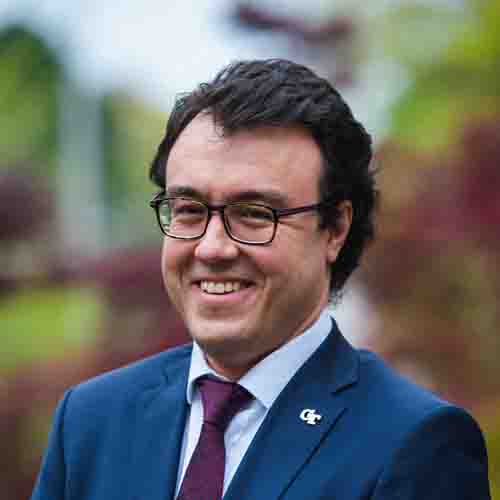


Burak Bagdatli
Burak Bagdatli received his B.S., M.S., and Ph.D. degrees in Aerospace Engineering from Georgia Institute of Technology. He is currently a research faculty member at Georgia Institute of Technology working within the Aerospace Systems Design Laboratory. His primary research areas are system of systems architectures, stochastic process simulation, and interactive visualizations.
Burak currently works on the following research projects:
- model-based systems engineering for exploring design spaces for commercial airline designs,
- simulating aerial firefighting operations,
- cost implications for a CO2 and Noise stringency options for commercial aviation,
- dynamic simulations of a race car with calibrations from physical experiments, and
- definition and potential implementations of zero-impact aviation at the fleet-level.
Burak also worked on many research projects in the past including
- identification of critical uncertainties in aerospace system design through simulation and propagation,
- modeling and analysis of new technologies, concepts, and operations for the Next Generation Air Transportation System,
- sustainable approaches for business jet aviation,
- large scale manufacturing data analysis and machine learning,
- long-term goal setting for low-carbon aviation,
- automated floor covering part definition based on MBSE requirements,
- coding simulations for architecture-based technology evaluation and capability tradeoffs,
- developing an interactive web-based course on electromechanical systems, analyzing, visualizing, and working with large-scale manufacturing data,
- creation of digital twin for manufacturing machines, and
- exploring design spaces for model-based commercial airline designs.
He is the instructor of two graduate-level classes on topics relating to system of systems architecting, modeling, simulation, design, and interpretation. He also teaches guest lectures in advanced design methods classes. His research interests include discrete event, agent-based, and mathematical simulations, digital twin for various phases of a program, and statistical modeling and visualizations. Before starting graduate school, he worked as a design engineer on a medium altitude high endurance UAV at Turkish Aerospace Industries.
+
Education
- Doctor of Philosophy, 2018, Georgia Institute of Technology, Atlanta, GA, USA
- Master of Science, Aerospace Engineering, 2010, Georgia Institute of Technology, Atlanta, GA, USA
- Bachelor of Science, Aerospace Engineering, 2007, Georgia Institute of Technology, Atlanta, GA, USA
+
Research
Interests
- Systems of Systems Studying, analyzing, and visualizing the cooperative aspects, system architectures, and capabilities, composable models
- Statistical Methods Use of Monte Carlo simulations, point estimators, and linear, non linear, and non-parametric regression in a systems design context
- Design Space Exploration Use of interactive visualization techniques paired with machine learning models to explore entire design and performance spaces for systems
- Decision Making Decision making methods relating to early system design, model-based systems engineering, design process improvements
- Manufacturing Investigate interactions between manufacturing processes in a factory, statistical and mechanical root-causes for cycle time variations
- Computer Simulations Research on mathematical graphs, Markov chains, Petri nets, discrete event, cellular automata, agent-based models
- Multi-Disciplinary Analysis and Optimization Connecting analyses with their systems engineering representations such that the analysis process can be managed from within Systems Engineering
+
Teaching
Instructor
- AE6393: Introduction to System of Systems Engineering Principles
- I have designed this course together with Dr. Griendling in 2012 and have been involved in teaching it 50–90% ever since. The name and numbers have varied over the year; however, it is known as the “System of Systems” course by the students.
- AE6394: System of Systems Engineering Applications
- This course grew out of the “System of Systems” course as the follow-on course. Students take both to complete their System of Systems Grand Challenges.
Guest Lecturer
- AE3310 Vehicle Performance (2014)
- AE3340 Design & Systems Engineering Methods (2018)
- AE6373 Advanced Design Methods I
- As part of my teaching assistantship, I gave 9–12 hours of lectures each year (2011–2013)
- Since 2014, I was invited to give about 3–9 hours of lectures each year to date
Teaching Assistantship
- AE6343 Aircraft Design I (2011–2013)
- AE6344 Aircraft Design II (2012–2014)
- AE6373 Advanced Design Methods I (2011–2013)
- AE6383 Applied Design Laboratory (2011–2013)
- AE8900MAV Special Problems (2012–2014)
- AE8801 Introduction to System of Systems Engineering Principles Laboratory (2013)
- AE8803MAV Introduction to System of Systems Engineering Principles (2012–2016)
- AE8804 System of Systems Engineering Applications (2014 and 2018)
+
Publications
Thesis
B. Bagdatli, “Architecture-based selection of modeling type for system of systems analysis, ” Ph.D. dissertation, School of Aerospace Engineering, Georgia Institute of Technology, Atlanta, GA, USA, Aug 2018. Available online.
Abstract
A methodology for selecting computer modeling methods for system of systems problems was proposed. Two hypotheses were stated and supported by subsequent experimentation: “system architectures are very closely related to conceptual models” and “depending on the architecture views deemed to be essential to describe a system of systems, there are a number of modeling techniques required to adequately model it”. The experiments were conducted in a systematic fashion using “element maps” that connect system of systems architecture elements to computer modeling elements. These element maps were developed to provide a repeatable scaffold in the translation of architectures into executable models. Using the element maps, eleven tests were performed on four different architectures varying in size and purpose. A process flow is designed and detailed that helps system of systems engineers with selecting computer modeling types and translating architectures into conceptual models that can be implemented in any computer language.
Publications
- Bagdatli, B., Cimtalay, S., Fields, T., Garcia, E., Peak, R. (2022). SysML State of the Art. In: Madni, A.M., Augustine, N., Sievers, M. (eds) Handbook of Model-Based Systems Engineering. Springer, Cham. doi: 10.1007/978-3-030-27486-3_13-1
- F. Karagoz, B. Bagdatli, Y. Cai, and D. N. Mavris, “Interactive Model-based Environment for Aircraft Family Conceptual Design Decisions,” AIAA Scitech Forum, 2021, doi: 10.2514/6.2021-0092.
- T. Puranik, A. Gharbi, B. Bagdatli, O. P. Fischer, and D. N. Mavris, “Benchmarking Deep Neural Network Architectures for Machining Tool Anomaly Detection,” ASTM International, vol. 4, no. 2, pp. 121–145, 2020, doi: 10.1520/SSMS20190039.
- B. Bagdatli, F. Karagoz, K. A. Reilley, and D. N. Mavris, “MBSE-enabled Interactive Environment for Aircraft Conceptual Sizing & Synthesis,” AIAA Scitech Forum, San Diego, CA, 2019, doi: 10.2514/6.2019-0497.
- B. Bagdatli, K. Griendling, and D. Mavris, “Challenges for simulating stochastic behavior in systems of systems,” INCOSE Insight, 15(2), Jul., pp. 29–31, 2012, doi: 10.1002/inst.201215229.
- B. Bagdatli and D. Mavris, “Use of high-level architecture discrete event simulation in a system of systems design,” 2012 IEEE Aerospace Conference, 2012, pp. 1–13, doi: 10.1109/AERO.2012.6187442.
- B. Bagdatli et al., “A method for examining the impact of interoperability on mission performance in a system-of-systems,” 2010 IEEE Aerospace Conference, 2010, pp. 1-15, doi: 10.1109/AERO.2010.5446884.
Contribution to Technical Reports
- ICAO Committee on Aviation Environmental Protection, “Appendix M3 Technology” in Report on the feasibility of a long-term aspirational goal (LTAG) for international civil aviation CO2 emission reductions, Appendix M3, 2022. Available online.
